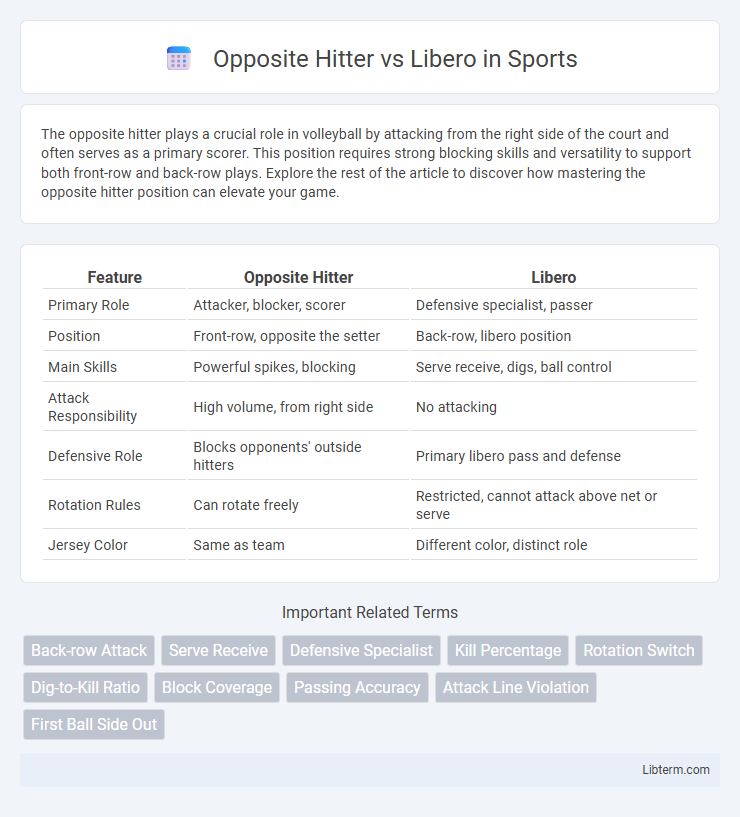The opposite hitter plays a crucial role in volleyball by attacking from the right side of the court and often serves as a primary scorer. This position requires strong blocking skills and versatility to support both front-row and back-row plays. Explore the rest of the article to discover how mastering the opposite hitter position can elevate your game.
Table of Comparison
| Feature | Opposite Hitter | Libero |
|---|---|---|
| Primary Role | Attacker, blocker, scorer | Defensive specialist, passer |
| Position | Front-row, opposite the setter | Back-row, libero position |
| Main Skills | Powerful spikes, blocking | Serve receive, digs, ball control |
| Attack Responsibility | High volume, from right side | No attacking |
| Defensive Role | Blocks opponents' outside hitters | Primary libero pass and defense |
| Rotation Rules | Can rotate freely | Restricted, cannot attack above net or serve |
| Jersey Color | Same as team | Different color, distinct role |
Understanding the Roles: Opposite Hitter vs Libero
The Opposite Hitter primarily focuses on offensive play, attacking from the right side and providing strong blocking against the opponent's outside hitters, while also contributing to defense. The Libero specializes in defensive skills, excelling in serve reception and digging to keep the ball in play, without participating in front-row attacks or blocks. Understanding these distinct roles enhances team strategy by balancing powerful offensive strikes from the Opposite Hitter with the Libero's exceptional ball control and defensive coverage.
Key Responsibilities on the Court
The opposite hitter is primarily responsible for powerful attacks from the right side, blocking opposing outside hitters, and contributing to the team's offense by scoring points. The libero specializes in defensive skills such as receiving serves, digging attacks, and ensuring precise ball control to facilitate smooth offensive transitions. Both positions require quick reflexes and game awareness but distinctly focus on offensive impact versus defensive stability.
Physical and Technical Skillsets Required
Opposite hitters require explosive power, agility, and strong jumping ability for effective attacking and blocking from the right side, combined with precise spiking and solid serving techniques. Liberos need exceptional reflexes, quick lateral movements, and superior ball control skills for precise digging, passing, and defensive coverage in the backcourt. While opposites excel in offensive versatility and height advantage, liberos prioritize agility, anticipation, and consistent reception under high-pressure situations.
Positioning and Movement During Play
Opposite hitters position themselves opposite the setter in the rotation, primarily operating from the right front and back row to maximize attacking opportunities and block against the opponent's outside hitter. Liberos specialize in defensive skills, positioning themselves in the back row with unrestricted movement to cover the court for digs, passes, and serve receptions. While opposites actively engage in both offensive attacks and blocks, liberos focus on quick lateral movement and anticipation to maintain ball control and facilitate team transitions.
Offensive Contributions: Who Scores More?
Opposite hitters typically score more points than liberos due to their primary role as offensive weapons, often leading attacks and finishing plays with powerful spikes. Liberos focus on defensive skills such as digs and receptions, rarely participating in front-row attacks or scoring attempts. The opposite hitter's position prioritizes offensive contributions, making them key scorers in volleyball matches.
Defensive Specialization: Libero’s Edge
Libero demonstrates superior defensive specialization, excelling in digs, serve receptions, and ball control compared to the opposite hitter. Unlike the opposite hitter, who primarily focuses on attacking and blocking, the libero consistently enhances team defense through rapid reactions and precise passing. This defensive edge allows the libero to stabilize back-row play and initiate effective offensive transitions.
Training Regimens and Drills for Each Role
Opposite hitters prioritize explosive power and vertical jump training to enhance spiking and blocking capabilities, incorporating plyometrics, upper body strength workouts, and hitting drills against varied defenses. Liberos focus on agility, quick reflexes, and defensive positioning, emphasizing reaction drills, passing accuracy exercises, and floor defense techniques to improve reception and digging skills. Both roles integrate video analysis and game-scenario simulations tailored to their specialized responsibilities on the volleyball court.
Impact on Team Strategy and Dynamics
The Opposite Hitter plays a crucial offensive role by providing powerful spikes and blocking against the opponent's outside hitters, significantly enhancing the team's attacking options and net defense. The Libero specializes in defense and serve reception, improving ball control and extending rallies, which allows the team to transition more effectively from defense to attack. Balancing the offensive threat of the Opposite Hitter with the defensive stability of the Libero shapes team dynamics by optimizing both scoring potential and defensive resilience.
Transitioning Between Opposite Hitter and Libero
Transitioning between opposite hitter and libero requires adapting from a dominant offensive role to a specialized defensive position, emphasizing quick reflexes and precise ball control. The opposite hitter focuses on powerful attacks and blocking, while the libero excels in serve reception, digs, and court coverage, demanding versatility and enhanced agility. Effective training for this transition includes developing both offensive hitting techniques and defensive skills such as passing accuracy and strategic positioning.
Choosing Your Path: Which Role Fits You Best?
Choosing between opposite hitter and libero depends on your skill set and playing style; opposite hitters excel in powerful attacks and blocking from the right side, requiring strong offensive and defensive capabilities. Liberos specialize in defensive skills, such as digging and precise passing, focusing on ball control and quick reflexes to stabilize the team's defense. Evaluating your strengths in hitting power, agility, and defensive instincts will help determine which role aligns best with your volleyball ambitions.
Opposite Hitter Infographic

 libterm.com
libterm.com